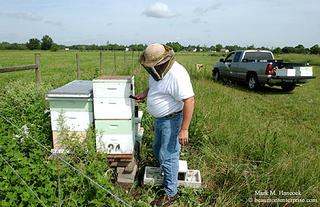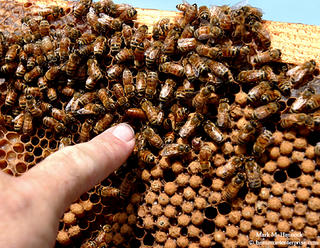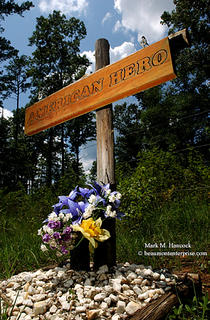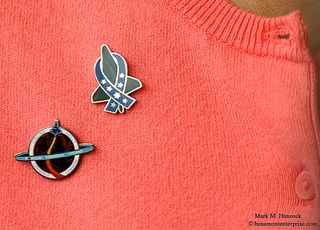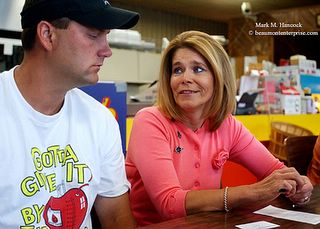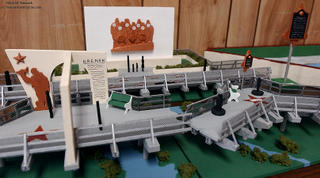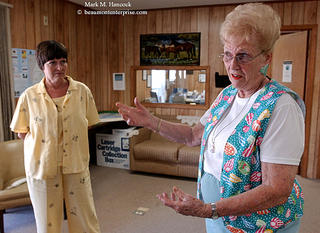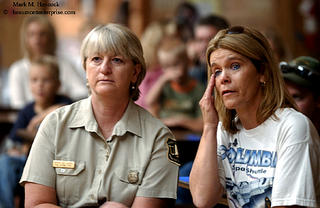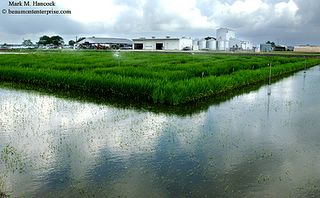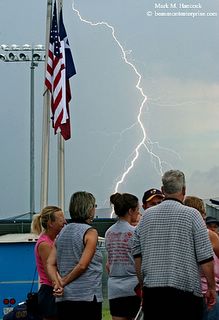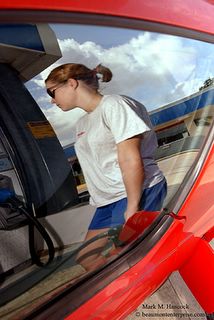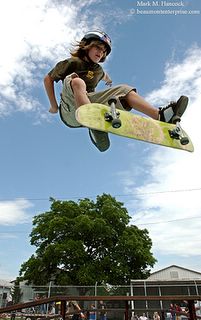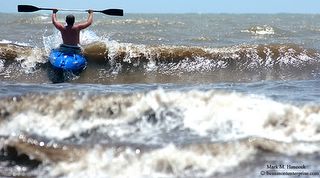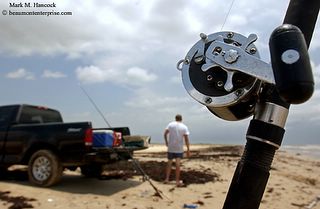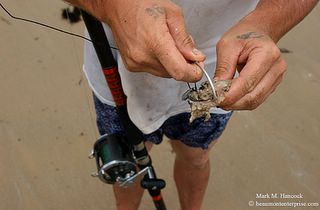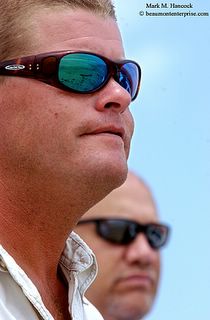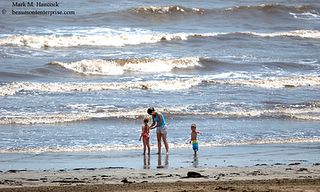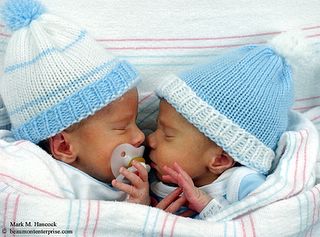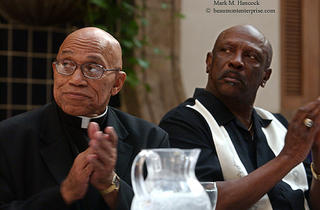An author is writing an "introduction to collegiate student publications" book. She asked me a set of questions about photojournalism. Considering how strongly I feel about the field, I might be the wrong person to ask.
However, it did force me to think about how miserable my work was when I first started down this path. Improper exposures, soft focus, missed moments and general cluelessness are all part of the learning curve. Every pro suffered through it in the beginning. It takes some slapping around (self-induced or via a mentor) to get past the initial failings.
I want to expand on some of these issues soon, but below is the bare minimum I think collegiate student journalists need to know.
For the pros who visit this humble corner of the blogosphere, consider how you would answer the questions below. If you disagree or feel something is amiss, please let me know (comment or e-mail), and I'll relay your thoughts to the author as well.
If you want to skip ahead to questions, use these numbers:
1 2 3 4 5 6 7 8 1. The audience for my book is primarily students working on their college newspapers. Some are journalism or photojournalism majors, many aren't and they may not have much background in the basics of journalism/photojournalism. Considering this, what do you think are some of the key things I should touch on in the photojournalism chapter?To capsulate photojournalism: photojournalists tell stories with visual verbs.
Photography is about documenting nouns (people, places and things). Journalism is about telling stories. Photojournalism is telling stories with photographs. However, while photographers use nouns, photojournalists must capture verbs (actions).
The verb is the key component of a photojournalistic image because news photographs are always accompanied with a caption or
cutline. These are two-sentence written summaries that include who, what, when, where, why and how. Additionally, these images frequently augment or promote a written news story.
Before we continue, we must understand still photography is the single most powerful medium of communication. Because of
the way the eyes and brain work, still photographs can become part of a viewer's memory in a matter of seconds.
Powerful images are literally burned into the neural network of a viewer's mind. Years later, viewers are able to describe photographs in detail after only a few seconds of initial examination.
Furthermore, photography cuts across all social, linguistic, educational, intellectual and age barriers. Within seconds, a three-year-old in any part of the world is able to understand emotions and actions captured in a photograph.
With this great power comes great responsibility. Accurate and compassionate visual reportage is also critically important to news outlets, subscribers and democracy as a whole. It must be executed to the highest ethical and technical standards.
Photojournalists must first become great story tellers. They must understand journalism, sociology and photography as well as or better than those professionals. Additionally, they must be driven, passionate, organized, clerical, courteous, flexible, artistic, physically capable and mentally agile.
Photojournalism is
not an easy job. It is
not a glamorous job. However, it's often
fun and satisfying. Most professional photojournalists can't imagine having another job.
College publications are excellent training grounds for young PJs. Collegiate publications allow PJs access to news and feedback. If taken seriously, these publications can lead to competition wins and eventually to freelance or staff jobs at major newspapers or magazines.
Because many student reporters don't have sufficient backgrounds in journalism, it's important to immerse oneself in the medium. Overall, the industry is contracting while the demand for top-notch reporters is rising (due to retirement). Consequently, there are no openings for minimally adequate reporters or PJs. Only the best and most passionate survive in this industry.
2. Can you tell me a bit about your experiences on student newspapers?
What are you most proud of? What do you know now about photojournalism that you wish you knew then?In college, I worked on the student publications as a writer, photojournalist, news editor, and editor-in-chief on the newspaper side and a PJ and writer on the magazine side.
I won several collegiate awards for both writing and photography. The most notable was first place for Story Illustration, Single Photo at the Columbia Scholastic Press Association Gold Circle Awards in 1995.
Looking back, I wish I had been more competitive and learned more about the business side of the profession while I was in college. It's important to learn early to survive financially in this profession. Otherwise, it takes more time and more work to create a reputation and achieve an acceptable level of income.
Everyone is cutting budgets and will gladly take quality work for less than it's worth. Low prices only damage the ability of PJs to acquire equipment and be available for assignments. It's easy to stay busy as a PJ. However, it's impossible to continue when PJs are averaging less than minimum wage or losing money while making images for cheap buyers.
Young PJs must learn the
bare minimum they must charge to break even under any circumstance. This includes the costs involved in renting all equipment required to complete a shoot. If the PJs already own the equipment, it saves them money. However, if the equipment breaks, they must rent it to complete the shoot. If the job bid price is too low, they immediately lose money and need to increase their workload simply to pay for the first shoot.
Additionally, PJs must keep as many rights as possible to their images. It's fine to accept extremely large sums for all rights, but anything less than $1,000 per frame is a potential loss. Student publications should never expect to have any rights beyond one-time use.
3. Student newspapers, perhaps even more than professional papers, cover a lot of speeches. What advice do you have for photojournalists trying to make interesting images out of speeches and meetings?I don't believe it's necessary to shoot talking heads. It's always better to arrive early and/or stay after the speech to get more natural images of the speaker interacting with other folks. Typically, the speaker are more relaxed after the speech than before, but it depends on the content of the speech.
If there's no way to avoid the dreaded lectern shot, try to shoot it from the side. This keeps the microphone out of the subject's face, it often requires a longer lens and the shallow depth of field helps clean up the background. Remember to shoot from both sides of the room to let page designers have more than one layout option.
4. What advice do you have on shooting sports?Again, I have
detailed instructions about many sports on my blog.
All team sports have the same starting sequence. The photographer must shoot a frame of the official
roster for both teams. Otherwise, there's no way to identify the players. Even if the photographer is given copies of the rosters, shoot a frame of each roster to keep the names in the archive with the images. Also, shoot signs to identify the venue's proper name.
For team sports, it's most import to take follow-up shots to identify players by their jersey numbers. Without these numbers, the player can't be confirmed and the greatest images in the world go unused. Corrections are unacceptable and kill a PJ's reputation.
Before covering a sporting event, look at as many images of the sport as possible. Analyze the successful images and understand how this image occurred. Photographers must ask themselves some questions. What were the players doing? How did the photographer make the image? What
equipment or access is required? Try to emulate the images you like and avoid failed images.
Because most sports are played in evenly-lit venues, images are about focus and timing. Although auto-focus lenses have become better in recent years, most student-PJs have manual lenses or instable AF lenses which are best focused manually.
Practice focusing skills on moving cars and other fast objects. Don't load film into the camera, simply follow objects and get a feel for keeping the plane of focus on the lead edge of the subject. Also, learn to keep both eyes open while shooting sports. The non-firing eye watches the action and predicts variables while the shooting eye concentrates on composition and focus.
Timing is also delicate. While shooting at 1/1000th of a second, there are 999 wrong times to shoot. Each camera has a slightly different lag time measured in millionths of seconds. PJs must be familiar enough with the camera to compensate for the lag time and nail the shot at the precise moment.
Most successful sports images are about collisions and emotions. Understand when and where collisions are most likely to occur and concentrate on those areas. These collisions are obvious in contact sports, but lesser collisions occur each time a player hits a ball or hits the ground after a jump.
Timing is also a matter of physics and gravity. Top level athletes fight gravity to make great plays. However, gravity is always the winner. Since the power of gravity is squared, understand that the player's inertia eventually equals zero at the apex of a jump. At this point, the PJ can shoot the player with the slowest shutter speed because the player is basically still (neither moving up or down) for a fraction of a second. In low-light venues, this is critical.
Likewise, when two players are running toward each other at equal speed in a contact sport, the moment of collision reduces each players speed to zero. Otherwise, the speed and panning direction can be predicted as the speed of the fastest player minus the speed of the slowest player at the point of collision (with some variation for the body mass of the players).
Beyond the basics, try to be able to see the players' eyes, which often means understanding which direction the players look, and shoot from the opposite direction. Also, learn how to light gyms and arenas with remote
flashes as quickly as possible or affordable. With recent camera advances, lighting skills are the barrier between amateurs and pros.
Finally, get the
fastest lenses available on a budget. Most sports are shot in low light. It's better to start with an f/2.8 prime 100mm lens than with a f/4 zoom 80~200mm lens because the image quality is better for the light level.
5. I've talked to so many journalists -- students and pros, photo people and word people -- who lament the poor communication between photographers and reporters, photo editors and word editors. What can students do to improve communication and collaboration in their newsrooms?Frankly, news is becoming decentralized. If reporters and PJs learn to be independent, they'll be better served. At major newspapers, top-tier reporters and PJs rarely go to the office. They file and receive assignments via e-mail or Web servers, complete the assignments on location and transmit the results in real time back to the office. Many freelancers work exclusively this way.
Since this process costs less and speeds production, I don't see the trend reversing 100 years to a central beehive where everyone wastes travel time to drop off the honey.
However, at the top-level newspapers and magazines,
photo requests from the reporters are frequently kicked back to the reporter for revision because they didn't care enough about the assignment to justify the
cost of a PJ.
Reporters make "photo requests." These go to the photo or assignment editor for approval or rejection. The photo editor makes the actual "photo assignment" for a photographer based on the photo request and photojournalist availability and travel budgets.
Lack of forethought on the part of a reporter causes an immediate rejection. Each assignment costs a company about $400. Reporters must remember their request must justify this expense. A reporter's request for a mug shot of someone s/he interviewed doesn't warrant a PJ when 499 other reporters are working on stories of crime, poverty, taxation, entertainment and sports while only 15 to 20 photojournalists are available on any given day at a large metro newspaper.
Simply stated, there is no such thing as a fast-breaking spectator sport or a deadline mug shot. Professional PJs are journalists first and demand the same lead time to make images as reporters need to collect quotes for a story. This time allows them to research the assignment and consider visual options based on access, previous images and other factors.
Last-minute assignments are reactionary and only allow PJs to shoot whatever is happening at the time it happens. The final results show the lack of forethought. Breaking news is breaking news for both reporters and PJs. Each gets what they can before deadline. Feature stories should never need to be handled as breaking news.
Because of the factors listed above, the most important communication a reporter can have with the PJ is on the photo request. The request should be accurate and detailed. It should let the PJ know the story line rather than a shopping list of shots, which are often impossible, improbable or unethical.
Armed with thorough knowledge of the story and its key contacts, PJs find the right images to supplement, support and promote the story. This is what the reporter should want and expect.
Meanwhile, the PJ should take the responsibility to collect important information such as names and cell phone numbers for reporters. They should also get quotes from remote locations to add to the story. However, this information can be e-mailed from the location to the reporter.
Consequently, the reporter should include their own cell phone number and e-mail address to exchange additional information with PJs.
Unlike professional publications, student publications should give PJs and reporters solid critiques about their treatment of the subject matter as well as the technical quality of their work. Reporters should say they're disappointed with the results of a photo request when the images fall flat. This should allow some dialog between how the assignment request was written and what actually happened in front of the lens.
If the PJ did the best with the information s/he was given, responsibility for lack-luster images falls onto the reporter. If the PJ failed to execute the assignment to its full potential with the information the reporter provided, the responsibility falls entirely on the PJ. If both sides accomplish their mission to the fullest of their abilities, the results should be recognizable. If either fails, the results are obvious as well.
6. Any advice on shooting portraits?Portraits show a small slice of a person's personality. Quality portraits take time. The PJ should get to know the subject (either in person or through the assignment and/or personal research) and try to illustrate some aspect of their personality in relation to the story. If the story is about a clown, the PJ should call ahead to be certain the subject is in clown make-up with appropriate props.
Unlike straight news photographs, portraits allow the photographer some control over the subject and environment. If the subject has a white plastic cup on their desk, a PJ could not ask for it to be removed during a news assignment. However, during a portrait assignment, it can be removed to make the image cleaner and better.
The common quality about portraiture is that the subject looks directly into the camera. This is the universal code to let readers know the subject knows this is a portrait and not a news event. This code means the portrait is posed and not real or even natural.
Although
commercial photographers prefer to have the subject look off axis, I personally believe this is lying to news readers unless the portrait is extreme in either its subject matter or lighting.
A studio-lit person waist deep in rattlesnakes juggling flaming chainsaws is allowed to look off axis if they must. However, convincing someone to do some action and claiming it's a "portrait" is absolutely forbidden. A PJ may get away with it once or twice, but their reputation is profoundly damaged if they're known for setting up their images and trying to pass them off as real.
I've heard the argument that the cutline clearly stated the image was a portrait, but this is a hollow excuse because most cutlines are modified before they're published. If it's a portrait, have them look into the lens and avoid confusion.
7. What can student journalists (including PJs) do to make their papers visually stirring?All journalists should take chances. Yes, reporters must ask the softball, background questions. PJs must take the standard safe shots. But once everyone knows they're covered and have something to publish, go out on a limb.
Reporters should always ask subjects, "What do you do?" Although the answer should include expected answers such as, "We will have a fire training session at 1 p.m. on Friday." It could also include an unexpected answer such as, "I like to make needlepoint pillows."
The second answer solicits a portrait of the firefighter with some of his/her needlepoint creations. The first answer creates an inside photo of the firefighter actually demonstrating his/her fitness to rescue citizens in need of help.
For an over-the-top example, the firefighter might pose for a portrait at the training grounds surrounded by flames while looking up from a needlepoint. Or, the firefighter might hold a needlepoint canvas toward the camera while a hole burns through the center of the canvas to reveal the firefighter's face.
In short, portraits show creativity. Reporters are welcome to help PJs arrange some of the extreme portraits by letting PJs know the subject is willing to have their portrait taken at the training ground with the needlework and will bring some extra canvases to burn.
However, if the reporter doesn't ask the right questions and relay the answers to the PJ, these facts may never be known about the subject. Even if the PJ learns this information at the shoot, it's often too late to make arrangements for a better image.
8. What other advice do you have for student newspaper photographers?Study everything and learn to think critically. If an assignment isn't complete, challenge the assignment writer. Don't accept weak assignments and don't make weak images. The final image has the PJ's name under it. Demand enough information from the reporters or conduct enough research on your own to make amazing images.
If necessary, withhold your name from inadequate assignments. If the images next to a particular reporter's stories consistently have no credit line, it tells readers and editors a lot about the reporter. News briefs don't carry bylines and neither should mug shots, copy shots or weak assignments.
I did this years ago when I felt ambushed by an assignment. It definitely got the attention of editors. I did my job and completed the assignment to the best of my abilities with the information and time I was allowed and the situation in which I found myself. However, I didn't feel the assignment or results met my minimum standard. Consequently, I refused to allow my name to be published with the image.
All heads immediately turned toward the person who made the weak request, and my reputation was not damaged by another person's lack of forethought or deliberate interference.
For college PJs, the library and Internet should be obsessions. Critically analyze every photo. Look carefully at the works of master photographers and understand how the master made the images. Look beyond the subject matter and study the
skeletal structure of the image,
element placement as well as the layers of information the photographer introduced. Concentrate on how they make images with clean backgrounds and separate subjects from other image elements.
Now is the time to become intimately familiar with the camera and
software as well as quickly
gaining subjects' trust and access. The technical mechanics of photography should become secondary to the act of visual reporting.
If a PJ is shooting with a digital camera, the standard minimum is
100 frames per assignment.
Work with the subject and use different lenses, angles and lighting until 100 or more frames have been created. Pick the best frame and hide the rest.
It's also important to become a "collegiate photojournalist." This implies a specific amount of skill and expertise with the camera. I like to compare photography levels to football because many new PJs understand the level of skill and practice required.
Many high school football players dream of becoming pro football players. However, it takes iron-willed determination to make it onto a college football team. Most collegiate football players never make the pros, but others could compete at the highest levels while in college.
Photojournalism requires the same level of confidence and talent. High school photographers learn to control their camera and can acquire some quality images. Collegiate PJs should be competing against their peers nationally and preparing for the leap to pro. This means collegiate PJs should be better than any high school photographers or any amateur (hobby) photographers with years of experience.
Pro football players are considered top athletes - not only in their sport, but also in terms of raw athletic ability and passion. To remain professionals, they must continue to grow and develop a record of significant accomplishments. "Bad days" are unacceptable for pro football players, they must perform at their peak each time they step onto the field. Pro PJs are the same.
Pro PJs should be able to handle any assignment around the world with absolute confidence and consistently provide images of a level higher than any other photographers. A pro is worthy of the title. They can literally create compelling, award-winning images at mundane assignments because they simply don't give up and have a wealth of visual knowledge to draw upon.
Although college PJs may only be taking their first steps along this path, they must quickly learn to run at a speed equal to their peers and faster than untrained amateurs. Otherwise, they won't make the leap to pro.
During this training time, it's critical to learn the
value of quality images and name recognition. Anyone can make a photograph. Telling stories with photographs is much harder and can command appropriate payment. Selling photo use rights cheaply quickly ends a budding career. Don't settle for less from yourself or your clients.
Enough for now,




